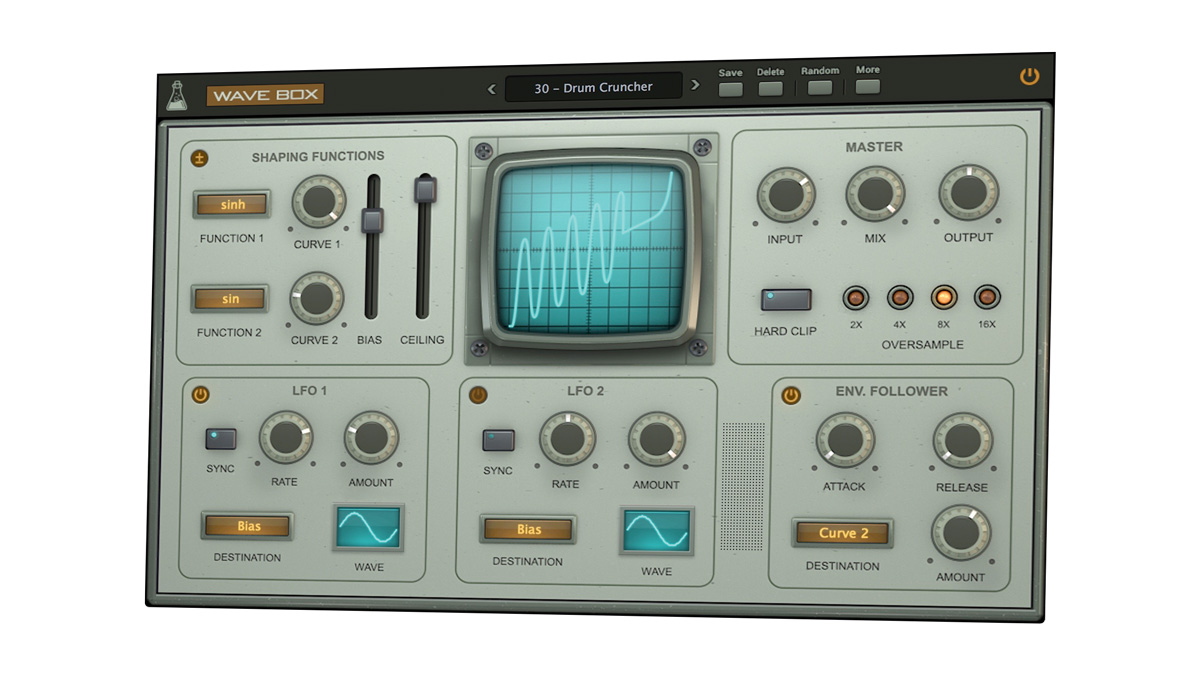MusicRadar Verdict
Balancing simplicity and depth in true AudioThing style, Wave Box is a powerful, fun distortion plugin for any producer.
Pros
- +
Two waveshapers.
- +
Asymmetrical and Symmetrical waveshaping with bias/mixing.
Cons
- -
No filter.
MusicRadar's got your back
Having set a new benchmark with the stellar Outer Space delay, AudioThing’s latest plugin has a lot to live up to.
Wave Box (VST/AU/AAX) is a dual waveshaper with a few nifty tricks up its sleeve...
In the Box
At the heart of Wave Box are its two waveshapers - Curve 1 and Curve 2 - each accessing a library of six waveshapes. These comprise sine, hyperbolic sine and tangent, floor- and ceiling-rounded square waves, and a linear function.
The Curve 1 and 2 knobs control the amount of shaping applied - increasing the ‘step resolution’ of the Floor and Round waves, for example, or tilting the linear function towards vertical.
The way in which the two shapers are combined depends on whether the plugin is in Symmetrical or Asymmetrical mode, as switched between using the top left button. In Asymmetrical mode, Curve 1 shapes the positive side of the signal and Curve 2 shapes the negative, with the Bias slider shifting the centre point between them up and down from its central (50%) position. In Symmetrical mode, both shapers process the entire signal, and Bias mixes them together.
Whichever mode Wave Box is in, lowering the Ceiling slider narrows the dynamic range of the waveshaping by compressing both sides of the curve(s) towards the centre line. The shape of the transfer wave resulting from all these adjustments and any modulation applied (see Throwing shapes) is visible in the ‘oscilloscope’.
Wave Box’s waveshaping sounds awesome on its own, but it’s really intended to be modulated by the onboard envelope follower and two LFOs.
The Envelope Follower tracks the input signal and outputs a modulation signal based on its amplitude at any given point, with Attack (1-500ms) and Release (1-1000ms) controls governing onset and disengagement. Both LFOs offer all the usual waveforms (including Random), adjustable phase, synced timings from 4 bars to 1/32T, and unsynced speeds up to 2kHz.
All three modulation sources are bipolar and share the same menu of Destination targets: Curve 1, Curve 2, Bias and Ceiling. Between them, they enable plenty of rhythmic and input-driven distortion design, but they’d be even better with the addition of the Mix parameter to all three Destination menus, and LFO Rate and Depth to that of the Envelope Follower.
In the Master section of the interface, the Input knob dials in attenuation or up to 12dB of overdrive, and the Out knob ranges covers the same range at the other end of the signal flow. Parallel processing is on hand via the Mix knob, while the Hard Clip button kicks in a limiter, and up to 16x oversampling (for balancing aliasing with CPU hit) can be activated using the four multiplier buttons.
Want all the hottest music and gear news, reviews, deals, features and more, direct to your inbox? Sign up here.
Finally, AudioThing’s ever-present randomisation system lets you scramble all parameters at the click of a button, with the option to render individual controls immune by locking them.
Ride the Wave
Wave Box not only sounds wicked but also demonstrates impressive versatility, despite its apparently straightforward architecture.
With Asymmetrical mode generating even harmonics and Symmetrical mode generating odd harmonics, the difference in results between the two is profound; and experimenting with Curve combinations opens up a huge range of distortion flavours, from gentle presence enhancement to industrial-scale decimation.
Of course, modulation is key to the whole - ahem - thing, with the LFOs bringing the rhythm and the envelope follower ideal for toughening up transients in drum tracks, adding bite to basslines and guitars, rounding off peaky signals and so on.
We’re perplexed by the glaring lack of a filter, though, as even a simple low-pass model would surely prove enormously useful, not just for reining in the plugin’s wonderful but frequently ear-shredding excesses, but also as a target for creative modulation.
That obvious omission aside, Wave Box packs a wealth of quality waveshaping into an intuitive, musical plugin at a great price.
Computer Music magazine is the world’s best selling publication dedicated solely to making great music with your Mac or PC computer. Each issue it brings its lucky readers the best in cutting-edge tutorials, need-to-know, expert software reviews and even all the tools you actually need to make great music today, courtesy of our legendary CM Plugin Suite.

